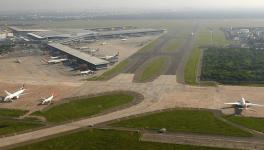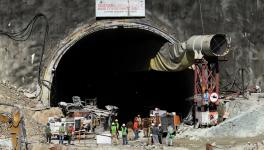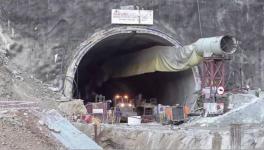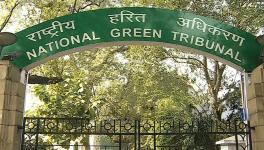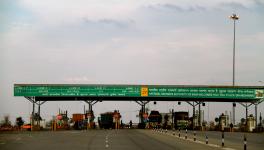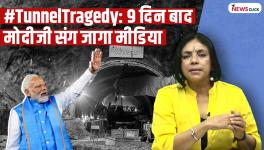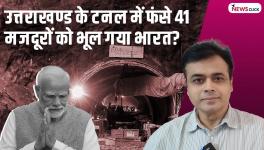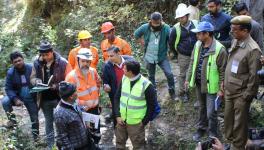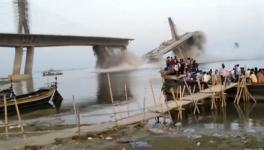'Punish Officials, Companies Responsible for Infra Failures'

Silkyara Tunnel, Uttrakhand. (PTI Photo)
Former Indian Railways chief engineer Alok Verma believes most tunnel collapses along the railroads and highways result from failing to prepare correct alignment plans. Unless each tunnel collapse is thoroughly investigated, this problem will keep escalating. Edited excerpts from an interview with Rashme Sehgal:
Rashme Sehgal: On December 1, Manish Khalkho, the managing director of the National Highways Infrastructure Development Corporation Ltd. (NHIDCL), said there had been at least 20 collapses along the Silkyara-Barakot tunnel in five years. Is that not a very large number?
Alok Verma: A claim of that nature, if true, calls for explanations. First and foremost, did a thorough survey and study of the rock formations along the alignment precede the selection of the tunnel alignment? The collapse of a 60-meter portion of a tunnel is an uncommon occurrence. If the roof has not been reinforced with steel and concrete at the tunnel's excavation face, it might collapse; however, a collapsed tunnel where this reinforcement has been finished is a serious mishap. Furthermore, given the frequency of collapses in the tunnel's completed section, why was the tunnel's location not altered following a comprehensive geological and geotechnical investigation?
RS: Pushkar Singh Dhami, the Chief Minister of Uttarakhand, has suggested that work on this tunnel could soon resume. Is that a risky proposition?
AV: Excavating the tunnel through 60 metres of debris will be slow and hazardous and must be performed carefully. The state of the rock formations surrounding the deposited debris has to be thoroughly evaluated before work can resume from the Silkyara end. The tunnel appears badly aligned because it passes through colluvium, a deposit of rock fragments and slope debris, rather than solid rock.
Experience also suggests that, in the Himalayas, twin-tube tunnels are preferable over single-tube ones as they improve constructability and relief and rescue.
RS: Let us turn to Indian Railway projects to construct new lines in the Himalayas. Could you explain why these projects have not been completed? Is it also because of tunnel collapses? Even the Kashmir line has seen such events.
AV: Between 2002 and 2011, the Indian Railways launched seven projects to build new lines in the higher reaches of the Himalayas beyond the foothills. The alignment of each of these lines was hurriedly prepared, projects sanctioned, and soon, contracts began to be awarded.
Construction started quickly after that, with a promise to complete each project in five years.
This pattern was set on the Kashmir rail link project in 2002–2004 and repeated on all the remaining six projects. No ground investigations were conducted to evaluate the hydrological, geological, or other conditions before the alignment for each project was prepared.
Further, the engineers failed to examine whether the numerous long tunnels, large bridges, and high cut-slopes that each of these alignments required could be designed to achieve the required level of safety and stability.
Soon after construction began on the Kashmir project, engineers realised that the rock strata were too weak and unstable to carry out construction at many places. About 12 tunnels collapsed, and many partly constructed bridges and cut-slopes have also been destroyed by landslides. For example, the 3.2-kilometre Tunnel No. 1 near Katra has been under [construction] for 20 years, but the railways have been unable to complete it because it is being built through a major geological fault zone, which makes the rock strata through which it is being built extremely weak and collapsible.
Tunnel No. 13 at Sawalkot, also on the Kashmir project, witnessed a major collapse at the Srinagar end in 2021, in which a large number of machines got buried.
The Railways finally had no choice but to shorten the length of the tunnel by removing the entire damaged portion. This tunnel has the worst possible alignment at this end because the rock cover is inadequate, and the rocks are weak.
Another disastrous tunnel collapse took place near the Sangaldan township, where the railway alignment runs along the main highway. The houses of many villagers were completely destroyed. The Kashmir rail alignment is in remote areas, and contractors generally manage to pay off the affected parties, so these have attracted little public attention.
In the first five years after sanction, progress on none of the abovementioned new line projects exceeded five to 10%.
RS: You had proposed a complete change of alignment in 2007. Please tell us why the Railway Board did not accept your proposal.
AV: I began by researching the Lesser Himalayas' geological features and the challenges associated with the Kashmir project. I also looked at the alignments of several planned and existing lines in other major mountain ranges, such as the Alps, the Andes, and the various mountainous regions of China and North America.
I reached two key conclusions. First, the main cause of the problems was the failure to carry out detailed geological and ground investigations to ensure that the alignments were properly prepared. Second, a slope-skirting alignment is fundamentally unsuitable.
I must emphasise that the slope-skirting alignment chosen for these projects requires constructing many very large bridges, long tunnels, and very steep cuttings, which would not be possible in the fragile geology of the Himalayas.
I opted for a new type of alignment, shorter and straighter than the existing one, which did not require so many large bridges and large cuttings on steep slopes. Further, the tunnels were placed deeper inside the mountains, away from the slope surface.
In November 2007, I officially submitted my proposal for an alignment change. Construction was suspended, and a committee of outside experts was appointed to examine my proposal. A Swiss consulting company was engaged to carry out ground surveys and investigations to examine the technical feasibility of the new type of alignment I had proposed. Sadly, the proposal for a change of alignment was scuttled through manipulation within the Railway Board.
Over the next five years (2009–14), the handling of the Kashmir project and the alignment review were examined by the Comptroller and Auditor General (CAG), the Public Accounts Committee (PAC), the Central Vigilance Commission (CVC), and the Delhi High Court in two separate cases. The PAC directed the Railway Board to take responsibility for the failure to prepare a proper alignment.
The Delhi High Court ordered the Railway Board to appoint an expert committee to examine my proposal for a change of alignment because the first expert committee had failed to do so. The new expert committee submitted its report in February 2015 and unanimously recommended that my alignment be adopted as it offered the most cost-effective solution for a high-capacity, stable, safe, and reliable line.
The committee also said this new type of alignment could serve as a model for other new line projects in the Himalayas. However, the Board insisted that construction continue on the existing alignment, claiming that construction would be completed by December 2018.
RS: What is the status of each of the seven new line projects in the Himalayas today?
AV: All these new line projects in the Himalayas should be considered a failure. Construction on these projects has dragged on for 15 to 20 years and may continue for several more years despite the government giving them the highest priority for timely completion.
Improper alignments have resulted in an astronomically high construction cost--around Rs 500 to Rs 700 crore per kilometre of the straight- line distance covered. It is about 10 times more than the average cost of lines in the other mountainous regions of the country. The line capacity is also seriously compromised.
We also need to factor in the high risk of passenger safety, security of the line in times of war and internal disturbances, and survivability in the event of major earthquakes and excessive rainfall. Without a doubt, running these lines will be a continual nightmare.
RS: Has the practice of not carrying out scientific and thorough alignment surveys changed in the Indian Railways?
AV: No. Recent cases show that alignments continue to be prepared without essential ground investigations. In 2017, the Railway Board approved plans for two of the biggest new line projects so far in the Himalayas: a 456-km line from Bilaspur in Himachal Pradesh to Leh in Ladakh and 327-km Char Dham lines to link Badrinath, Kedarnath, Gangotri, and Yamunotri in Uttarakhand. Both alignment plans were riddled with the same fatal flaws witnessed in the ongoing projects.
The Leh plan failed to account for the impact of the high elevation of 3,500-5,000 metres above mean sea level and its impact on the feasibility and cost of constructing long tunnels and large bridges.
On September 28, 2020, the Northern Railway engineers came to me to discuss the plans after I had written articles about them. Both of these projects appear to have been put on hold since then.
In 2019, the Railway Board gave in-principle approval to the project to build a semi-high speed line on Standard Gauge, which is narrower than the Indian Broad Gauge. The alignment completely ignored the geological challenges and difficult terrain, which included backwaters and highlands.
If the government does not take action against the officials and companies accountable for these three alignments, the nation will be left with even more disastrous projects on top of the ones already underway.
RS: Why should preparing thorough Detailed Project Reports (DPRs) that look at geology and terrain before determining rail and road project alignment be so difficult in India?
AV: The Indian Railways codified the rules for carrying out surveys and ground investigations for designing alignments more than a hundred years ago. But railway engineers have repeatedly failed to follow these rules.
In fact, the Railway Board has officially stated that it was under pressure from the government to demonstrate progress on the ground, so it had to begin construction of the Kashmir line without conducting sufficient ground investigations. This claim was made before the Delhi High Court and the PAC.
RS: So, what are the most important lessons from the Railway projects in the Himalayas?
AV: No project should be sanctioned without a properly surveyed and designed alignment. Unless alignment is based on a thorough investigation of the geological and other ground conditions, it is impossible to successfully build stable and safe lines in the Himalayas at a reasonable cost within a reasonable timeframe of four to six years after project sanction.
With proper surveys and ground investigations, the size of bridges and cut-slopes can be reduced, and the alignment can be placed away from adverse geological features like fault lines, unfavourably inclined sedimentary rocks and other weak and unstable rock formations.
RS: What are your other suggestions for the rail and road projects?
AV: To salvage the seven ongoing Railway projects, we should stop working on them for six to 12 months. Punishment is required for the officials in charge of the poor alignment survey and design and the DPRs and feasibility reports that went along with them. Furthermore, in the future, it would be preferable to construct new lines in the Himalayas on a meter gauge rather than the broad gauge.
We must also determine whether proper alignment surveys were done for each road widening project, including the new tunnel projects, particularly the high-altitude tunnels in Ladakh.
Twin-tube tunnels should be preferred for ease of construction and efficient rescue and relief. The option of constructing a new road rather than widening an existing highway should be taken into consideration for future capacity enhancement projects.
Rashme Sehgal is an independent journalist.
Get the latest reports & analysis with people's perspective on Protests, movements & deep analytical videos, discussions of the current affairs in your Telegram app. Subscribe to NewsClick's Telegram channel & get Real-Time updates on stories, as they get published on our website.









